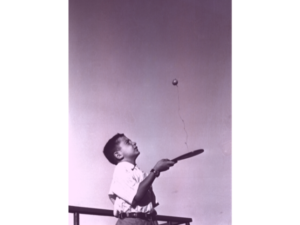This guest post was written by Lindsey Scott of A Subtle Revelry. She is a stay-at-home mom of three beautiful kids who loves to cook, make crafts, and keep her little ones entertained. When she’s not busy chasing after her kids, Lindsey enjoys blogging about her experiences as a mom. She likes to share recipes, crafting tips, and ideas for keeping all the family occupied.

Playing outdoors helps improve children’s mental health by exposing them to sunshine and fresh air. Keeping kids away from screens and encouraging them to spend time playing outside promotes their emotional stability, physical health, teamwork, and a positive relationship with nature.
This list offers suggestions for a variety of outdoor games for all types of kids and spaces.
Minute to Win It Games for Kids
Minute to win it games are short, fun activities that can be played with basic equipment—often items you already have at home. These games promote teamwork and challenge kids by encouraging them to compete either against a clock or against each other. Here are the three most popular minute to win it games for your family to try:
- Pinging It Out: Each player has a tissue box full of Ping-Pong balls strapped around their waist. Players must jump up and down to bounce the balls out of the box. The first player to empty their box is the winner.
- Potato and Spoon Race. Give each player a spoon and a potato. Players must run across the lawn to the finish line while balancing the potato on the spoon, without touching the potato or letting it fall. The first player to cross the finish line wins the game.
- Musical Chairs. The players stand in a circle around some chairs. There must be more players than chairs. Play music while the players run around the circle of chairs. When the music stops, each player should sit down on a chair. Anyone left standing is out of the game. Remove one chair for each new round, until there is only one chair left. The player who gets the last chair wins.
DIY Outdoor Jigsaw Puzzle
Creating a life-size DIY outdoor jigsaw puzzle is a fun activity for the whole family. Both making the puzzle and putting it together provide a great opportunity for cognitive, emotional, and physical stimulation. Make sure you have the necessary equipment like a giant sheet of cardboard, glue, scissors, and a life-sized picture to cut out. Kids usually spend about an hour making the puzzle. This project is a great fit for kids of all ages, depending on the puzzle size.

Red Rover
Red rover is a team game that does not require any equipment and is suitable for any age. The game can be adapted to younger children by shortening the distance between the two teams. Playing this game encourages kids to work as a team.
Separate into two teams, hold hands, and form two lines facing each other, 10 feet apart. Team one decides who they want to invite over, and calls out “red rover, red rover, let [child’s name] come over!”
The selected player runs across and tries to break through the linked hands of the other team. If they can’t get through, they join the other team. However, if they succeed, they can choose one player to take back with them to their team. The game ends when everyone has joined one team, or when everyone has had enough.
Sack Race
Give each child a burlap bag or a pillowcase. For older kids, use king-sized or body-pillow-sized pillowcases. The players climb into their sacks and stand behind the starting line. At the starting signal, the players jump towards the finish line, holding their sacks up with their hands. The first child to reach the finish line wins. Sack races are helpful for strengthening gross motor coordination and promoting a healthy competitive spirit in kids.
Blind Bucket Pitch
You need a bucket and a ball for this two-player game. One player—the pitcher—stands facing away from their teammate—the catcher—with a few feet between them, and holds the ball above their head. The pitcher tosses the ball behind them, and the catcher jumps to catch the ball in the bucket. If the catcher misses, the players swap roles. The winner is the player with the most catches. In addition to improving gross motor coordination, this game is a wonderful exercise because the kids have to run around while trying to catch the ball.
Hit to One Hundred
Kids of all ages can play this game using a Ping-Pong paddle and Ping-Pong ball. Each player holds the paddle, palm up, and tries to bounce the Ping-Pong ball in the air 100 times without dropping the ball. If no one succeeds, the player with the highest score wins. If more than one player succeeds, the winners compete to see who can continue the longest without dropping the ball. This game is excellent for improving hand-eye coordination and can be adapted for all ages by changing the number of hits needed.

I Spy With My Little Eye
Choose one player to start the game as the spy. The spy chooses an item that’s visible to everyone and says, “I spy with my little eye something beginning with [the first letter of the object].” The other players must guess the name of the object. If no one can guess, the spy gives the next letter of the word. The first person to guess correctly takes a turn as the spy. Continue playing until every player has had a turn being the spy. This game helps to improve concentration, listening, and spelling skills.





Leave a Reply